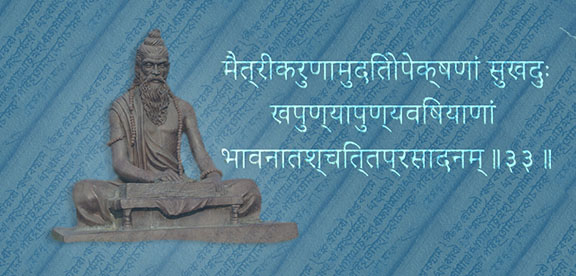 In this interview, Reverend Jaganath Carrera, an Integral Yoga master teacher and author of Inside the Yoga Sutras, explains how the heart of meditation can be understood through an unlocking of the term “nirodha,” which Patanjali uses in the second sutra of the Yoga Sutras. Patanjali prescribes a holistic system to help cultivate an environment in which nirodha can thrive and the fruits of meditation can blossom.
In this interview, Reverend Jaganath Carrera, an Integral Yoga master teacher and author of Inside the Yoga Sutras, explains how the heart of meditation can be understood through an unlocking of the term “nirodha,” which Patanjali uses in the second sutra of the Yoga Sutras. Patanjali prescribes a holistic system to help cultivate an environment in which nirodha can thrive and the fruits of meditation can blossom.
Integral Yoga Magazine (IYM): What do you mean by the subtle mechanics of meditation?
JC: The subtle mechanics of meditation refers to movement, to flow. The essence of the Yoga Sutras is contained in sutra 1.2: “Yogas chitta vritti nirodha.” Meditation is really about nirodha. When Patanjali defines nirodha, he talks about it as vahita: a calm flow and not something rigid and static. If you look at the words dharana and dhyana, dharana, has the root meaning of, “to hold something.” There are several other meanings that have to do with bearing and conveying. So it’s not just holding, but it also bears and conveys. The idea is that you are trying to cultivate a movement of mind toward something and, Patanjali says, that something should be uplifting and something that you like. The root of dhyana, dhi, is always related to reflection and spiritual ideas—any kind of meditation, spiritual ideas or thought. So, we have this movement from dharana to dhyana. In dharana you are cultivating a vehicle that takes you to an introspective state where spirit unfolds for you over time. So, the subtle mechanics of meditation always involve movement, meditation’s not static.
IYM: Most people associate meditation with stillness—no movement at all.
JC: I think one of the reasons people have difficulty with meditation is precisely because they have the idea that they have to restrict the attention rather than direct the attention. It could be kind of a subtle point but, in practice, it’s a tremendous difference. If you think, “I have to bolt my awareness to the object of meditation,” that creates a kind of closed space. It’s hard to create movement and depth in your practice. I try to teach the idea of a focused, tranquil flow of attention, without the mind wandering all over the place. So, it’s not holding or stopping the mind but it’s also not letting the mind run all over. It’s a subtle feeling of not being restricted or bound and, at the same time, your attention isn’t all over the place; it’s more of a matter of the attitude that you bring. It’s not whether it wanders or not, it’s the attitude. With this approach, there’s a dropping of the tension that you have to perform to achieve something. You want the mind to be in love with the object of meditation so it will flow toward it and be absorbed by it. Patanjali is talking about moving awareness toward something. Samadhi is a constant flow of cognition toward the object. In that movement there’s a natural transcendence of the ego sense into samadhi rather than holding still and waiting for a lightning bolt to hit. [Laughs]
IYM: What is samadhi?
JC: In sutra 1.17, Patanjali gives four levels of samadhi. It’s like a beautiful travel guide as to what happens in every meditation: an evolution from gross object to subtle object to a sattvic mind, a mind which is not grasping for outside stimulation anymore. Even with gross and subtle samadhis, there is still some grasping, some vyutthana (external grasping). As the mind goes deeper, it gets to the sattvic (sananda) samadhi. It’s a blissful state because you are not grasping anymore. In sutra 1.41, Patanjali says: “Just as the naturally pure crystal assumes shapes and colors of objects placed near it, so the yogi’s mind, with its totally weakened modifications, becomes clear and balanced and attains the state devoid of differentiation between knower, knowable and knowledge. This culmination of meditation is samadhi.” He uses the Sanskrit word grahitri, from the root, grah, to grasp. Even when you are sitting in meditation, the manas part of the mind is still grasping, doing the vyutthana dance. It doesn’t stop just because your eyes are closed. You may cut out some visual input, but you might hear things and even if you’ve gone deeper, the mind is still looking for things to grasp, that’s its nature; that activity continues. I love that image of grasping—a hand sticking out looking for something, grasping.
IYM: How do you understand and define nirodha?
JC: One of the deeper meanings of nirodha that you only get if you go below the surface, is the root rudh. Rudh can mean to restrict or arrest, but it also means to avert. The ni, which comes in front, means “down” or “into.” So you put it together and you get the idea of directing the flow of the mind down, or into or, in common language, going within. Patanjali talks about a state of mind, vyutthana, which means externalization of the mind. It’s the activity that the mind engages in on a daily basis to judge if something is appealing, beneficial and will bring happiness. Is it worth our effort? You want to know the nature of something because you believe it’s separate from the Self. Then you judge by asking yourself, “Will I get happiness or satisfaction from this object or experience?”
The mind is constantly moving outward to find happiness that way. You could say that nirodha is the polar opposite of vyutthana. If you look at nirodha as averting down into, it’s the opposite of the mind going outward. We come back to the idea of the mind flowing: centrifugally out, in vyutthana, and centripetally in nirodha. Patanjali, understanding that the mind is in the habit—or has momentum—of going out says that every moment of nirodha predisposes you to other moments of nirodha. I envision it like a flywheel, with nirodha acting like a centripetal flywheel. Every time you say a mantra, study a sutra, meditate or do any yogic activity, it’s like giving a push to the nirodha flywheel. I believe that’s why we hear the ancient texts say that every yogic action is never wasted—it means something you do is giving a push. So, at some point in our lives, that movement will have more momentum or power than the internal moving flywheel. If you can fill your life with moments that give the inner flywheel a nudge, at some point it will gain prominence over the externally directed flywheel. It’s at that point you are firmly rooted in the spiritual path. This momentum has reached critical mass.
IYM: You talk about vritti as movement, as a twirling.
JC: Vritti can literally be defined: “to twirl.” When you look at the Yoga Sutras as a whole, this concept of flow and movement echoes throughout it but, that doesn’t always comes across easily in translation. Patanjali defines dhyana as the continuous flow: ekatanata. Eka means one, and tanata means flow—from the root tan, to reach or extend toward. An analogy would be the rain that falls. If the water represented all thoughts, we would have some that soak into the ground, some that collect in puddles, lakes or oceans and some water that will form streams and rivers. But all water flows to the sea. Maybe meditation is one-pointed in the way that a river is one-pointed in flowing to the sea, as compared to water in puddles and lakes. It is moving, flowing and it has energy in and behind it that takes it directly to the sea, its home. Sri Gurudev often used that analogy. There’s nothing fixed in that kind of one-pointedness. It’s purposeful and the word dhyana seems to imply a spiritual context—a mind flowing toward its source. So, coming back to the term “vritti,” it makes me think that maybe Patanjali spent a lot of time watching water and so he compares the mind to a whirlpool, to foam and he speaks of this flow of consciousness. The substratum of the mind stays the same—like the deeper part of the ocean that is always still, and the majority of activity we see is on top.
IYM: What part does regularity in one’s meditation practice play?
JC: Patanjali gives guidelines for practice in sutra 1.14: “Practice becomes firmly grounded when well attended to for a long time, without break and in all earnestness.” If you do this, deep meditation will happen; it’s the nature. Meditation will flow toward that samadhi. And the way to cultivate regularity is through falling in love with meditation. You know how teens, when they fall in love, stare in each other’s eyes—it’s not a practice, they don’t force it. It’s the same with your meditation practice. If you force it, that’s like jumping around in a pool of water—it creates havoc in the mind. It can add so many layers and a part of my mind will object to what was happening: “That wasn’t good enough. Why is my mind not cooperating?” and so on. So, there’s judgment there, and because you feel that you’re failing, you start exerting even more of an effort and wind up in a mess. You can’t force the mind; it has to fall in love with the object of meditation. So, you have to cultivate an environment wherein the overriding thought has to be, “I know the benefits of what I’m doing. This is going to be great.” Meditation should be something we love; it should be fun, and then everyone would get enlightened. The world needs a lot of easeful, peaceful, useful people. Whenever Gurudev was asked what the goal of Yoga is, he would reply, “To be easeful, peaceful and thus useful.” That’s the single greatest definition of Yoga on the planet!

Rev. Jaganath Carrera
Reverend Jaganath Carrera is a senior disciple of Sri Gurudev and and Integral Yoga Minister with over 40 years of teaching experience in the various branches, practices and theories of Yoga. He has taught in the U.S.A. and abroad in universities, prisons and Yoga centers and has been a principle speaker and coordinator of many Integral Yoga Teacher Training Certification programs in Hatha Yoga, Raja Yoga and in meditation. He organized the Integral Yoga Ministry and has lectured at interfaith programs. He is the founder of the Yoga Life Society.

